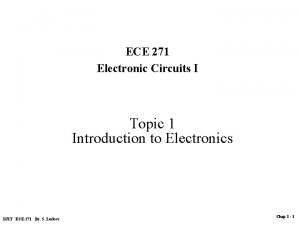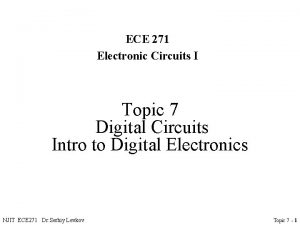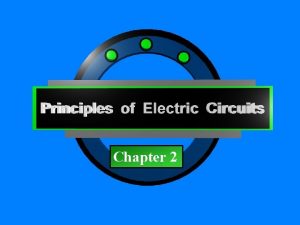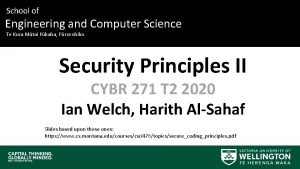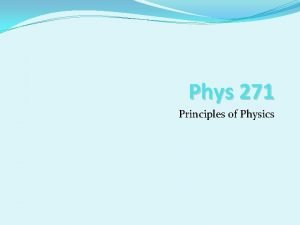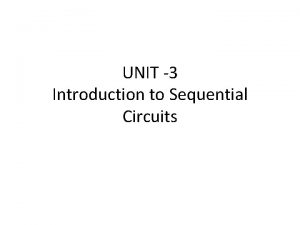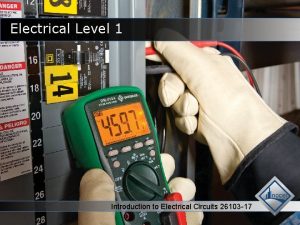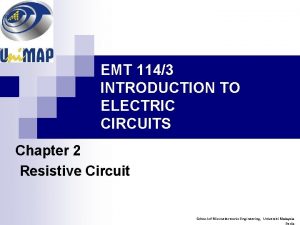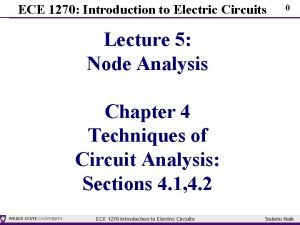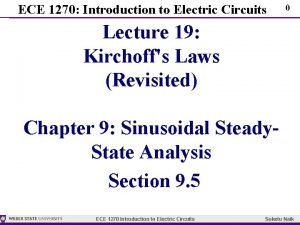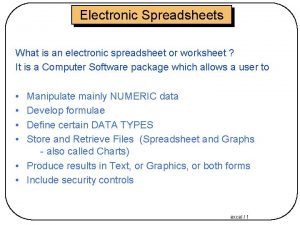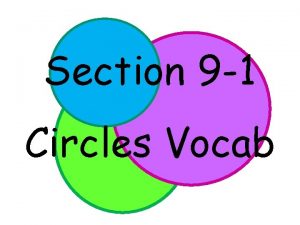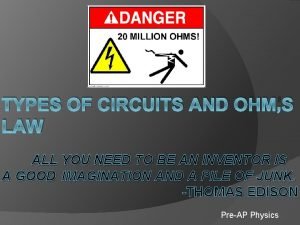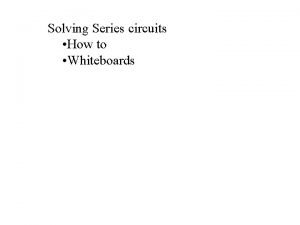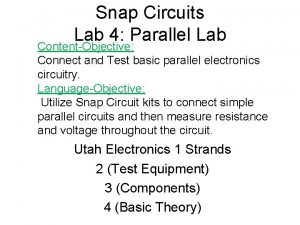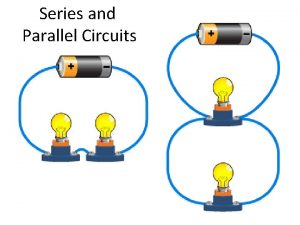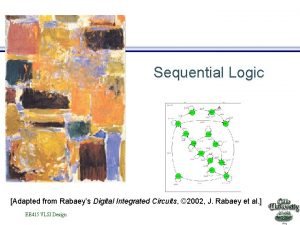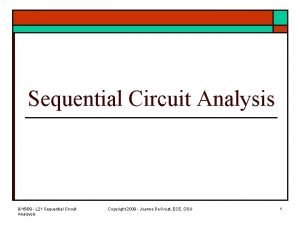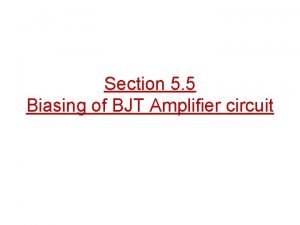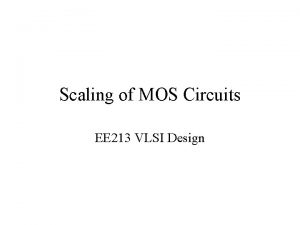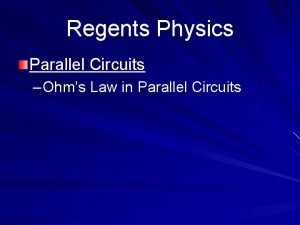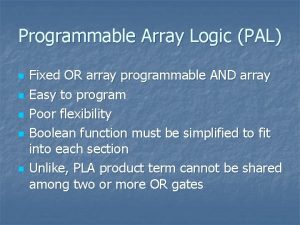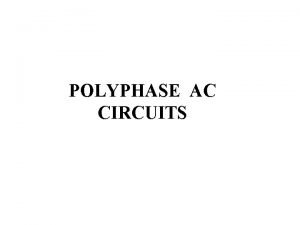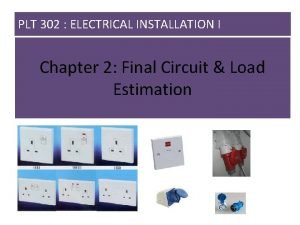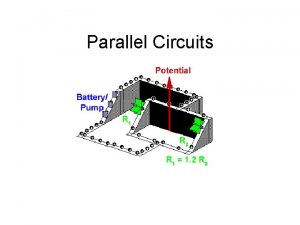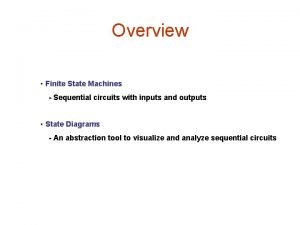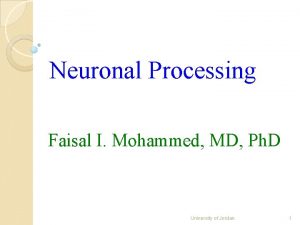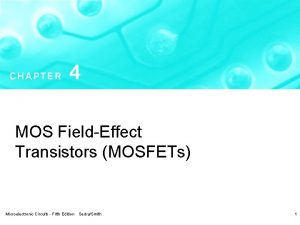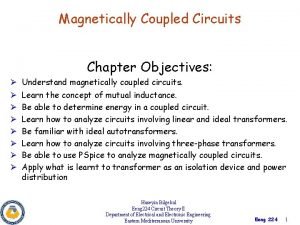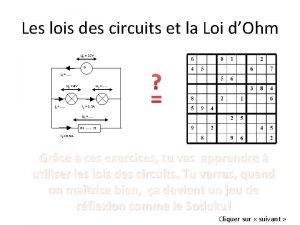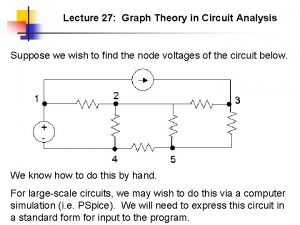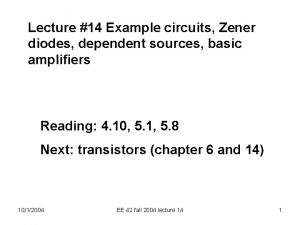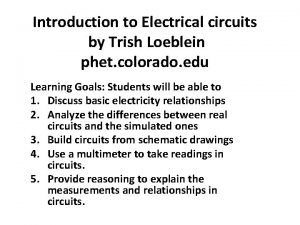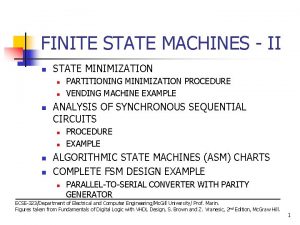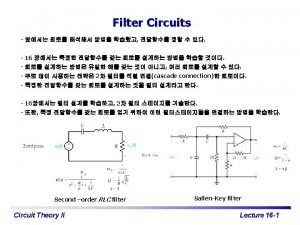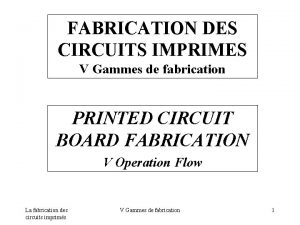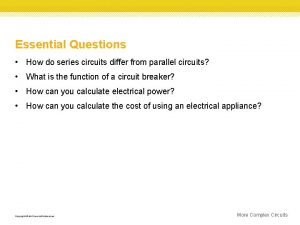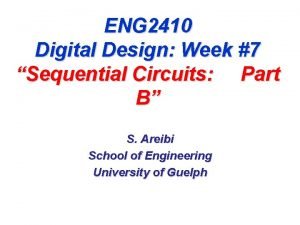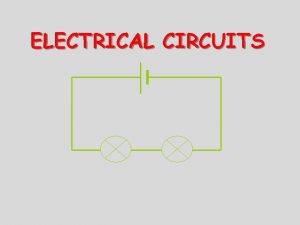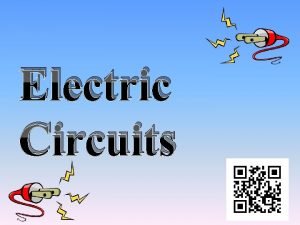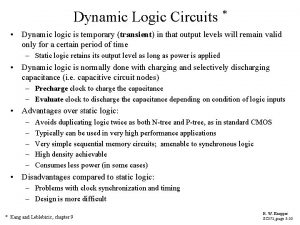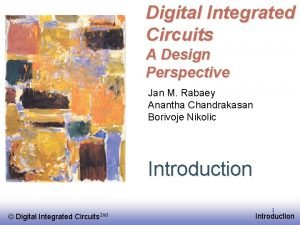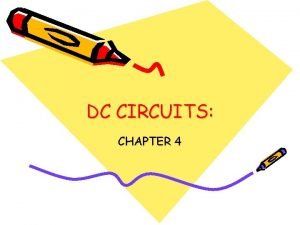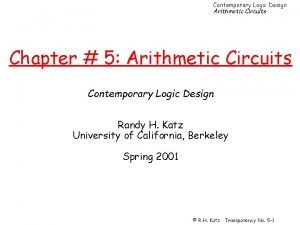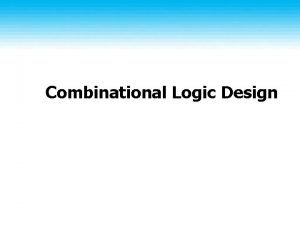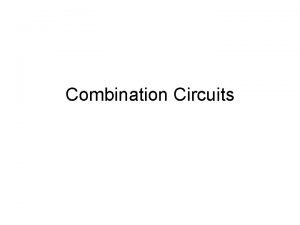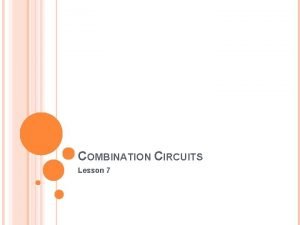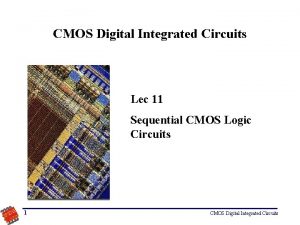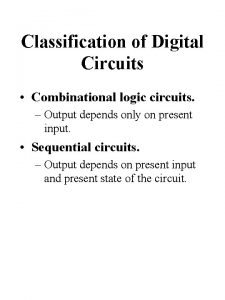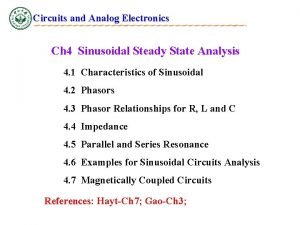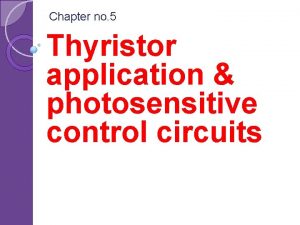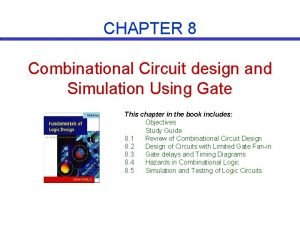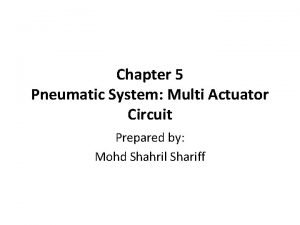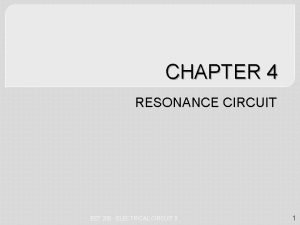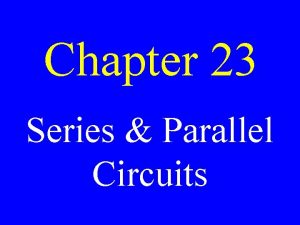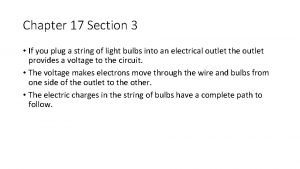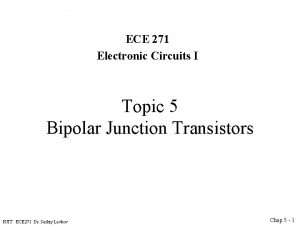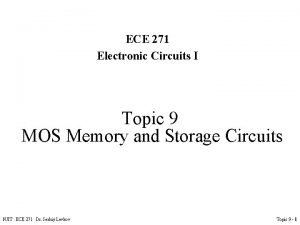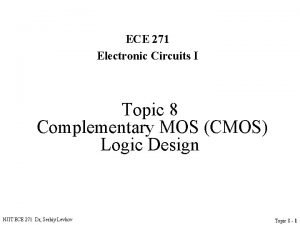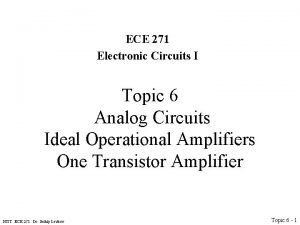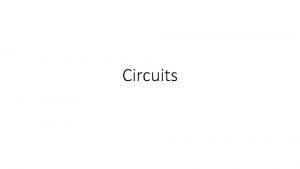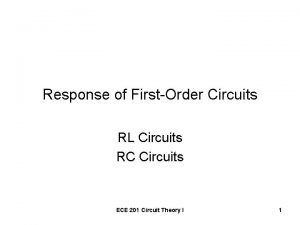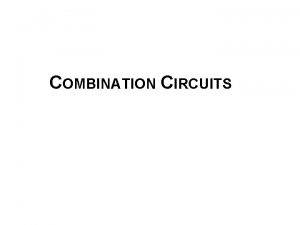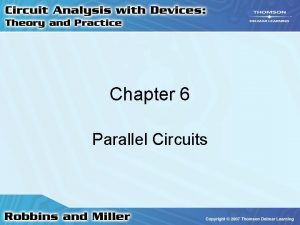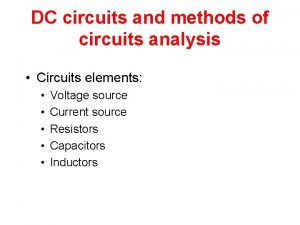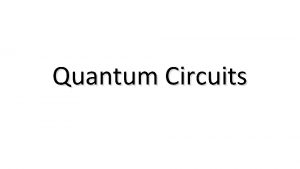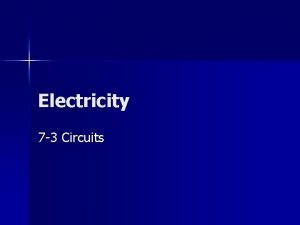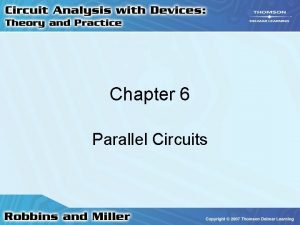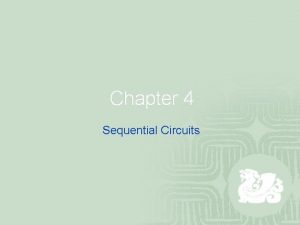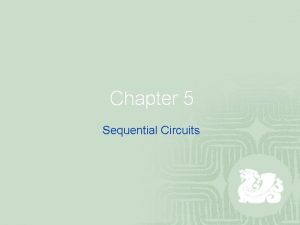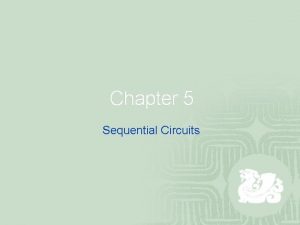ECE 271 Electronic Circuits I Topic 1 Introduction




















































































- Slides: 84

ECE 271 Electronic Circuits I Topic 1 Introduction to Electronics NJIT ECE-271 Dr. S. Levkov Chap 1 - 1

Topic Goals • Explore the history of electronics. • Describe classification of electronic signals. • Introduce tolerance impacts and analysis. NJIT ECE-271 Dr. S. Levkov Chap 1 - 2

1. The Subject of the Course • The subject of the course is modern electronics, or microelectronics. • Microelectronics refers to the integrated-circuit (IC) technology • IC – can contains hundreds of millions of components on a IC chip with the area of the order 100 sq. mm. • Subject of study: - electronic components/devices that can be used singly (discrete circuits) - electronic components/devices that can be used as components of the IC NJIT ECE-271 Dr. S. Levkov Chap 1 - 3

2. Brief History The Start of the Modern Electronics Era It can be said that the invention of the transistor and the subsequent development of the microelectronics have done more to shape the modern era than any other invention. Bardeen, Shockley, and Brattain at Bell Labs - Brattain and Bardeen invented the bipolar transistor in 1947. NJIT ECE-271 Dr. S. Levkov The first germanium bipolar transistor. Roughly 50 years later, electronics account for 10% (4 trillion dollars) of the world GDP. Chap 1 - 4

Electronics Milestones 1874 Braun invents the solid-state rectifier (using point contact based on lead sulphide) 1906 De. Forest invents triode vacuum tube. 1907 -1927 First radio circuits developed from diodes and triodes. 1925 Lilienfeld field-effect device patent filed. 1947 Bardeen and Brattain at Bell Laboratories invent bipolar transistors. 1952 Commercial bipolar transistor production at Texas Instruments. 1956 Bardeen, Brattain, and Shockley receive Nobel prize. NJIT ECE-271 Dr. S. Levkov 1958 Integrated circuits developed by Kilby (TI) and Noyce and Moore (Fairchild Semiconductor) 1961 First commercial IC from Fairchild Semiconductor 1963 IEEE formed from merger of IRE and AIEE 1968 First commercial IC opamp 1970 One transistor DRAM cell invented by Dennard at IBM. 1971 4004 Intel microprocessor introduced. 1978 First commercial 1 -kilobit memory. 1974 8080 microprocessor introduced. 1984 Megabit memory chip introduced. 1995 Gigabite memory chip presented. Chap 1 - 5

Evolution of Electronic Devices Vacuum Tubes Discrete Transistors SSI and MSI Integrated Circuits VLSI Surface-Mount Circuits NJIT ECE-271 Dr. S. Levkov Chap 1 - 6

Evolution of Electronic Devices A work of art from the Museum of Modern Art, Paris NJIT ECE-271 Dr. S. Levkov Chap 1 - 7

Microelectronics Proliferation • The integrated circuit was invented in 1958. • World transistor production has more than doubled every year for the past twenty years. NJIT ECE-271 Dr. S. Levkov Chap 1 - 8

Microelectronics Proliferation • The integrated circuit was invented in 1958. • World transistor production has more than doubled every year for the past twenty years. • Every year, more transistors are produced than in all previous years combined. • Approximately 1018 transistors were produced in a recent year. NJIT ECE-271 Dr. S. Levkov Chap 1 - 9

Microelectronics Proliferation • The integrated circuit was invented in 1958. • World transistor production has more than doubled every year for the past twenty years. • Every year, more transistors are produced than in all previous years combined. • Approximately 1018 transistors were produced in a recent year. • To compare: – Number of cells in a human body - Chap 1 - 10 NJIT ECE-271 Dr. S. Levkov

Microelectronics Proliferation • The integrated circuit was invented in 1958. • World transistor production has more than doubled every year for the past twenty years. • Every year, more transistors are produced than in all previous years combined. • Approximately 1018 transistors were produced in a recent year. • To compare: – Number of cells in a human body - 1014 Chap 1 - 11 NJIT ECE-271 Dr. S. Levkov

Microelectronics Proliferation • The integrated circuit was invented in 1958. • World transistor production has more than doubled every year for the past twenty years. • Every year, more transistors are produced than in all previous years combined. • Approximately 1018 transistors were produced in a recent year. • To compare: – Number of cells in a human body - 1014 – Number of seconds elapsed since Big Bang – NJIT ECE-271 Dr. S. Levkov Chap 1 - 12

Microelectronics Proliferation • The integrated circuit was invented in 1958. • World transistor production has more than doubled every year for the past twenty years. • Every year, more transistors are produced than in all previous years combined. • Approximately 1018 transistors were produced in a recent year. • To compare: – Number of cells in a human body - 1014 – Number of seconds elapsed since Big Bang – 1017 NJIT ECE-271 Dr. S. Levkov Chap 1 - 13

Microelectronics Proliferation • The integrated circuit was invented in 1958. • World transistor production has more than doubled every year for the past twenty years. • Every year, more transistors are produced than in all previous years combined. • Approximately 1018 transistors were produced in a recent year. • To compare: – Number of cells in a human body - 1014 – Number of seconds elapsed since Big Bang – 1017 – Number of ants in the world - NJIT ECE-271 Dr. S. Levkov Chap 1 - 14

Microelectronics Proliferation • The integrated circuit was invented in 1958. • World transistor production has more than doubled every year for the past twenty years. • Every year, more transistors are produced than in all previous years combined. • Approximately 1018 transistors were produced in a recent year. • To compare: – Number of cells in a human body - 1014 – Number of seconds elapsed since Big Bang – 1017 – Number of ants in the world - roughly 50 transistors for every ant in the world. *Source: Gordon Moore’s Plenary address at the 2003 International Solid State Circuits Conference. NJIT ECE-271 Dr. S. Levkov Chap 1 - 15

Rapid Increase in Density of Microelectronics Memory chip density versus time. NJIT ECE-271 Dr. S. Levkov Microprocessor complexity versus time. Chap 1 - 16

Device Feature Size • Feature size reductions enabled by process innovations. • Smaller features lead to more transistors per unit area and therefore higher density. • • • NJIT ECE-271 Dr. S. Levkov SSI – small scale integration (< 102) MSI – medium SI (102 - 103) LSI – large SI (103 - 104) VLSI – very large SI (104 - 109) ULSI & GSI– ultra large SI & gigascale integration (> 109) Chap 1 - 17

3. Types of Signals • Analog signals take on continuous values - typically current or voltage. NJIT ECE-271 Dr. S. Levkov Chap 1 - 18

3. Types of Signals • Analog signals take on continuous values - typically current or voltage. • Digital signals appear at discrete levels (do not confuse with discrete times). NJIT ECE-271 Dr. S. Levkov Chap 1 - 19

3. Types of Signals • Analog signals take on continuous values - typically current or voltage. • Digital signals appear at discrete levels (do not confuse with discrete times). • Usually we use binary signals with only two levels • One level is referred to as logical 1 and logical 0 is assigned to the other level. • Typically: - was standard for many years used now. • Bipolar levels also exist NJIT ECE-271 Dr. S. Levkov Chap 1 - 20

Analog and Digital Signals Analog signal • Analog signals usually are continuous in time and in values. NJIT ECE-271 Dr. S. Levkov Chap 1 - 21

Analog and Digital Signals Analog signal • Analog signals usually are continuous in time and in values. NJIT ECE-271 Dr. S. Levkov Discrete time signal • Sampled, discrete time signals are discrete in time (values are typically separated by fixed time intervals). • The values are continuous. • Needs digitization. Chap 1 - 22

Analog and Digital Signals • Sampled discrete time signal NJIT ECE-271 Dr. S. Levkov Chap 1 - 23

Analog and Digital Signals • Sampled discrete time signal NJIT ECE-271 Dr. S. Levkov • Digitized discrete time signal discrete time and digitized discrete values. • The values are not continuous – belong to a finite set. Chap 1 - 24

Analog and Digital Signals • Sampled discrete time signal NJIT ECE-271 Dr. S. Levkov • Digitized discrete time signal discrete time and digitized discrete values. • The values are not continuous – belong to a finite set. Chap 1 - 25

Analog and Digital Signals • Sampled discrete time signal NJIT ECE-271 Dr. S. Levkov • Digitized discrete time signal discrete time and digitized discrete values. • The values are not continuous – belong to a finite set. Chap 1 - 26

Digital-to-Analog (D/A) Conversion • The input is a binary number • Let’s introduce and then define NJIT ECE-271 Dr. S. Levkov Chap 1 - 27

Digital-to-Analog (D/A) Conversion • The input is a binary number • Let’s introduce and then define • The least significant bit (LSB) - the smallest possible binary number (smallest voltage change) is known as resolution of the converter. NJIT ECE-271 Dr. S. Levkov Chap 1 - 28

Digital-to-Analog (D/A) Conversion • The input is a binary number • Let’s introduce and then define • The least significant bit (LSB) - the smallest possible binary number (smallest voltage change) is known as resolution of the converter. • The most significant bit (MSB) - NJIT ECE-271 Dr. S. Levkov ? Chap 1 - 29

Digital-to-Analog (D/A) Conversion • The input is a binary number • Let’s introduce and then define • The least significant bit (LSB) - the smallest possible binary number (smallest voltage change) is known as resolution of the converter. • The most significant bit (MSB) - NJIT ECE-271 Dr. S. Levkov Chap 1 - 30

Digital-to-Analog (D/A) Conversion • The input is a binary number • Let’s introduce and then define • The least significant bit (LSB) - the smallest possible binary number (smallest voltage change) is known as resolution of the converter. • The most significant bit (MSB) • Then for an n-bit D/A converter, the output voltage is expressed as: NJIT ECE-271 Dr. S. Levkov Chap 1 - 31

Digital-to-Analog (D/A) Conversion • The input is a binary number • Let’s introduce and then define • The least significant bit (LSB) - the smallest possible binary number (smallest voltage change) is known as resolution of the converter. • The most significant bit (MSB) • Then for an n-bit D/A converter, the output voltage is expressed as: NJIT ECE-271 Dr. S. Levkov Chap 1 - 32

Digital-to-Analog (D/A) Conversion • The input is a binary number • Let’s introduce and then define • The least significant bit (LSB) - the smallest possible binary number (smallest voltage change) is known as resolution of the converter. • The most significant bit (MSB) • Then for an n-bit D/A converter, the output voltage is expressed as: NJIT ECE-271 Dr. S. Levkov Chap 1 - 33

Analog-to-Digital (A/D) Conversion • Analog input voltage Vx is converted to the nearest n-bit number that represent VO - the closest (WRT to the accuracy = VLSB /2) value to the Vx • Output is approximation of input due to the limited resolution of the n-bit output. Error is expressed as: NJIT ECE-271 Dr. S. Levkov Chap 1 - 34

A/D Converter Transfer Characteristic (input-output) NJIT ECE-271 Dr. S. Levkov Chap 1 - 35

A/D Converter Transfer Characteristic (input-output) NJIT ECE-271 Dr. S. Levkov Chap 1 - 36

A/D Converter Transfer Characteristic (input-output) NJIT ECE-271 Dr. S. Levkov Chap 1 - 37

A/D Converter Transfer Characteristic (input-output) NJIT ECE-271 Dr. S. Levkov Chap 1 - 38

A/D Converter Transfer Characteristic (input-output) NJIT ECE-271 Dr. S. Levkov Chap 1 - 39

A/D Converter Transfer Characteristic (input-output) NJIT ECE-271 Dr. S. Levkov Chap 1 - 40

A/D Converter Transfer Characteristic (input-output) NJIT ECE-271 Dr. S. Levkov Chap 1 - 41

A/D Converter Transfer Characteristic (input-output) NJIT ECE-271 Dr. S. Levkov Chap 1 - 42

A/D Converter Transfer Characteristic (input-output) NJIT ECE-271 Dr. S. Levkov Chap 1 - 43

A/D Converter Transfer Characteristic (input-output) NJIT ECE-271 Dr. S. Levkov Chap 1 - 44

A/D Converter Transfer Characteristic (input-output) NJIT ECE-271 Dr. S. Levkov Chap 1 - 45

A/D Converter Transfer Characteristic (input-output) NJIT ECE-271 Dr. S. Levkov Chap 1 - 46

4. Notational Conventions • In many circuits the signal will be a combination of the dc and time varying values. • Total signal = DC bias + time varying signal • Resistance and conductance - R and G with same subscripts will denote reciprocal quantities. Most convenient form will be used within expressions. NJIT ECE-271 Dr. S. Levkov Chap 1 - 47

5. Circuit Theory Review: Thévenin and Norton Equivalent Circuits Thévenin Norton NJIT ECE-271 Dr. S. Levkov Chap 1 - 48

5. Circuit Theory Review: Thévenin and Norton Equivalent Circuits Thévenin Norton NJIT ECE-271 Dr. S. Levkov Chap 1 - 49

5. Circuit Theory Review: Thévenin and Norton Equivalent Circuits Thévenin Norton NJIT ECE-271 Dr. S. Levkov Chap 1 - 50

Circuit Theory Review: Find the Thévenin Equivalent Voltage Problem: Find the Thévenin equivalent voltage at the output. Solution Approach: Voltage source vth is defined as the output voltage with no load. NJIT ECE-271 Dr. S. Levkov Chap 1 - 51

Circuit Theory Review: Find the Thévenin Equivalent Voltage NJIT ECE-271 Dr. S. Levkov Chap 1 - 52

Circuit Theory Review: Find the Thévenin Equivalent Voltage Applying KCL at the output node, Current i 1 can be written as: Substituting into previous expression: NJIT ECE-271 Dr. S. Levkov Chap 1 - 53

Circuit Theory Review: Find the Thévenin Equivalent Voltage (cont. ) Using the given component values: and NJIT ECE-271 Dr. S. Levkov Chap 1 - 54

Circuit Theory Review: Find the Thévenin Equivalent Resistance NJIT ECE-271 Dr. S. Levkov Chap 1 - 55

Circuit Theory Review: Find the Thévenin Equivalent Resistance Problem: Find the Thévenin equivalent resistance. Solution Approach: Find Rth as the output equivalent resistance with independent sources set to zero. NJIT ECE-271 Dr. S. Levkov Test voltage vx has been added to the previous circuit. Applying vx and solving for ix allows us to find the Thévenin resistance as vx/ix. Chap 1 - 56

Circuit Theory Review: Find the Thévenin Equivalent Resistance (cont. ) Applying KCL, where we get NJIT ECE-271 Dr. S. Levkov , or Chap 1 - 57

Circuit Theory Review: Find the Norton Equivalent Circuit Problem: Find the Norton equivalent circuit. Solution approach: Evaluate current through output short circuit. NJIT ECE-271 Dr. S. Levkov Chap 1 - 58

Circuit Theory Review: Find the Norton Equivalent Circuit NJIT ECE-271 Dr. S. Levkov Chap 1 - 59

Circuit Theory Review: Find the Norton Equivalent Circuit Problem: Find the Norton equivalent circuit. Solution approach: Evaluate current through output short circuit. A short circuit has been applied across the output. The Norton current is the current flowing through the short circuit at the output. NJIT ECE-271 Dr. S. Levkov Chap 1 - 60

Circuit Theory Review: Find the Norton Equivalent Circuit (cont. ) Applying KCL, Where Thus Short circuit at the output causes zero current to flow through RS. Rth is equal to Rth found earlier. NJIT ECE-271 Dr. S. Levkov Chap 1 - 61

Final Thévenin and Norton Circuits vth = 0. 718 vi in = (2. 55 x 10 -3)vi Check of Results: Note that vth = in. Rth and this can be used to check the calculations: in. Rth=(2. 55 m. S)vi(282 ) = 0. 719 vi, accurate within round -off error. NJIT ECE-271 Dr. S. Levkov Chap 1 - 62

6. Signal spectrum Any periodic signal can be represented in the form of Fourier series: 0=2 /T (rad/s) is the fundamental radian frequency and f 0=1/T (Hz) is the fundamental frequency of the signal. 2 f 0, 3 f 0, 4 f 0 , …. . are called the harmonic frequencies. Alternative representation: NJIT ECE-271 Dr. S. Levkov Chap 1 - 63

Fourier Series example For example, a square wave is represented by the following Fourier series: Signal Spectrum The spectrum of the periodic signal is the graph of the Fourier coefficients vs the harmonic frequencies. Periodic signals have discrete spectra. Non periodic signals have continuous spectra often occupying a broad range of frequencies. NJIT ECE-271 Dr. S. Levkov Chap 1 - 64

Frequencies of Some Common Signals • • • Audible sounds Baseband TV FM Radio Television (Channels 2 -6) Television (Channels 7 -13) Maritime and Govt. Comm. Cell phones and other wireless Satellite TV Wireless Devices 20 Hz - 20 0 - 4. 5 88 - 108 54 - 88 174 - 216 - 450 1710 - 2690 3. 7 - 4. 2 5. 0 - 5. 5 KHz MHz MHz MHz GHz Show the Fourier applet here NJIT ECE-271 Dr. S. Levkov Chap 1 - 65

7. Circuit Element Variations • All electronic components have manufacturing tolerances. – Resistors can be purchased with 10%, 5%, and 1% tolerance. (IC resistors are often 10%. ) – Capacitors can have asymmetrical tolerances such as +20%/-50%. – Power supply voltages typically vary from 1% to 10%. • Device parameters will also vary with temperature and age. • Circuits must be designed to accommodate these variations. • We will use worst-case and Monte Carlo (statistical) analysis to examine the effects of component parameter variations. NJIT ECE-271 Dr. S. Levkov Chap 1 - 66

Tolerance Modeling • For symmetrical parameter variations Pnom(1 - ) P Pnom(1 + ) Pnom - is the parameter specification - is the tolerance • For example, a 10 K resistor with 5% percent tolerance could exhibit the resistance in the following range of values: 10 k(1 - 0. 05) R 10 k(1 + 0. 05) 9, 500 R 10, 500 Chap 1 - 67 NJIT ECE-271 Dr. S. Levkov

Circuit Analysis with Tolerances • Worst-case analysis – Parameters are manipulated to produce the worst-case min and max values of desired quantities. – This can lead to over design since the worst-case combination of parameters is rare. – It may be less expensive to discard a rare failure than to design for 100% yield. NJIT ECE-271 Dr. S. Levkov Chap 1 - 68

Circuit Analysis with Tolerances • Worst-case analysis – Parameters are manipulated to produce the worst-case min and max values of desired quantities. – This can lead to over design since the worst-case combination of parameters is rare. – It may be less expensive to discard a rare failure than to design for 100% yield. • Monte-Carlo analysis – Parameters are randomly varied to generate a set of statistics for desired outputs. – Based on that we calculate the average values and optimize the design so that failures due to parameter variation are less frequent than failures due to other mechanisms. – In this way, the design difficulty is better managed than a worstcase approach. NJIT ECE-271 Dr. S. Levkov Chap 1 - 69

Worst Case Analysis Example Problem: Find the nominal and worst-case values for output voltage and source current. Solution: • Unknowns: VOnom, VOmin , VOmax, IInom, IImin, IImax. • Approach: Find nominal values and then select R 1, R 2, and VI values to generate extreme cases of the unknowns. Nominal Source current: NJIT ECE-271 Dr. S. Levkov Nominal voltage solution: Chap 1 - 70

Worst-Case Analysis Example (cont. ) Now we need to figure out how to find the min and max possible of the voltage and current in question. NJIT ECE-271 Dr. S. Levkov Chap 1 - 71

Worst-Case Analysis Example (cont. ) Now we need to figure out how to find the min and max possible of the voltage and current in question. Rewrite VO to help us determine how to find the worst-case values. NJIT ECE-271 Dr. S. Levkov Chap 1 - 72

Worst-Case Analysis Example (cont. ) Now we need to figure out how to find the min and max possible of the voltage and current in question. Rewrite VO to help us determine how to find the worst-case values. VO is maximized for max VI, R 1 and min R 2. VO is minimized for min VI, R 1, and max R 2. NJIT ECE-271 Dr. S. Levkov Chap 1 - 73

Worst-Case Analysis Example (cont. ) Now we need to figure out how to find the min and max possible of the voltage and current in question. Rewrite VO to help us determine how to find the worst-case values. VO is maximized for max VI, R 1 and min R 2. VO is minimized for min VI, R 1, and max R 2. NJIT ECE-271 Dr. S. Levkov Chap 1 - 74

Worst-Case Analysis Example (cont. ) Now we need to figure out how to find the min and max possible of the voltage and current in question. Rewrite VO to help us determine how to find the worst-case values. VO is maximized for max VI, R 1 and min R 2. VO is minimized for min VI, R 1, and max R 2. NJIT ECE-271 Dr. S. Levkov Chap 1 - 75

Worst-Case Analysis Example (cont. ) Worst-case source currents: NJIT ECE-271 Dr. S. Levkov Chap 1 - 76

Worst-Case Analysis Example (cont. ) Worst-case source currents: NJIT ECE-271 Dr. S. Levkov Chap 1 - 77

Worst-Case Analysis Example (cont. ) Worst-case source currents: Check of Results: The worst-case values range from 14 -17 percent above and below the nominal values. The sum of the three element tolerances is 20 percent, so our calculated values appear to be reasonable. NJIT ECE-271 Dr. S. Levkov Chap 1 - 78

Monte Carlo Analysis • All parameters are selected randomly from the possible distributions • Circuit is analysis is performed and solution is found • Many such solutions are performed and statistics are gathered. • The analysis can be done using programs like MATLAB, Mathcad, SPICE, or a spreadsheet to complete a statistically significant set of calculations. • For example, with Excel , a resistor with 5% tolerance can be expressed as: The RAND() function returns random numbers uniformly distributed between 0 and 1. NJIT ECE-271 Dr. S. Levkov Chap 1 - 79

Monte Carlo Analysis Result WC WC Histogram of output voltage from 1000 case Monte Carlo simulation. NJIT ECE-271 Dr. S. Levkov Chap 1 - 80

Monte Carlo Analysis Example Problem: Perform a Monte Carlo analysis and find the mean, standard deviation, min, and max for VO, IS, and power delivered from the source. Solution: • Unknowns: The mean, standard deviation, min, and max for VO, IS, and PS. • Approach: Use a spreadsheet to evaluate the circuit equations with random parameters. NJIT ECE-271 Dr. S. Levkov Chap 1 - 81

Monte Carlo Analysis Example (cont. ) Monte Carlo parameter definitions: Circuit equations based on Monte Carlo parameters: Results: Vo (V) II (m. A) P (m. W) NJIT ECE-271 Dr. S. Levkov Avg 4. 96 0. 276 4. 12 Nom. 5. 00 0. 278 4. 17 Stdev 0. 30 0. 0173 0. 490 Max WC-max Min WC-Min 5. 70 5. 87 4. 37 4. 20 0. 310 0. 322 0. 242 0. 238 5. 04 -3. 29 -- Chap 1 - 82

Temperature Coefficients • Most circuit parameters are temperature sensitive. P = Pnom(1+ 1∆T+ 2∆T 2) where ∆T = T-Tnom Pnom is defined at Tnom • Most versions of SPICE allow for the specification of TNOM, T, TC 1( 1), TC 2( 2). • SPICE temperature model for resistor: R(T) = R(TNOM)*[1+TC 1*(T-TNOM)+TC 2*(T-TNOM)2] • Many other components have similar models. NJIT ECE-271 Dr. S. Levkov Chap 1 - 83

Numeric Precision • Most circuit parameters vary from less than +- 1 % to greater than +- 50%. • As a consequence, more than three significant digits is meaningless. • Results in the text will be represented with three significant digits: 2. 03 m. A, 5. 72 V, 0. 0436 µA, and so on. NJIT ECE-271 Dr. S. Levkov Chap 1 - 84
 Kcl theory
Kcl theory Nmos inverter with depletion load
Nmos inverter with depletion load Advantages of parallel circuits over series circuits
Advantages of parallel circuits over series circuits Principles of electronic circuits
Principles of electronic circuits Rounding to ten thousands
Rounding to ten thousands Onluğa yuvarlama makinesi
Onluğa yuvarlama makinesi Cybr271
Cybr271 Round 673 422 to the nearest hundred
Round 673 422 to the nearest hundred Ddu 271
Ddu 271 Mastering physics login
Mastering physics login 271 21
271 21 Is the electronic exchange of money or scrip
Is the electronic exchange of money or scrip Electronic news gathering and electronic field production
Electronic news gathering and electronic field production Clincher examples
Clincher examples Narrowed down topic examples
Narrowed down topic examples Sequential
Sequential Nccer introduction to electrical circuits
Nccer introduction to electrical circuits Introduction to electric circuits
Introduction to electric circuits Introduction to electric circuits
Introduction to electric circuits Ece
Ece Slides presentation
Slides presentation Circle vocab
Circle vocab Lesson outline lesson 3 describing circuits answers
Lesson outline lesson 3 describing circuits answers Virtual circuit switching example
Virtual circuit switching example Types of circuits and ohms law
Types of circuits and ohms law Crossed extensor reflex
Crossed extensor reflex Isolated instrumentation amplifier
Isolated instrumentation amplifier Solving series circuits
Solving series circuits Snap circuits project lab
Snap circuits project lab Current in parallel vs series
Current in parallel vs series Facts about series circuits
Facts about series circuits Non bistable sequential circuits
Non bistable sequential circuits Analysis of sequential circuits
Analysis of sequential circuits Emitter feedback resistor
Emitter feedback resistor Scaling of mos circuits in vlsi
Scaling of mos circuits in vlsi Internal resistance
Internal resistance Programmable array logic circuits
Programmable array logic circuits Complete vs incomplete circuit
Complete vs incomplete circuit Polyphase ac
Polyphase ac Ckt motor perlis
Ckt motor perlis Contoh rangkaian sekuensial
Contoh rangkaian sekuensial Types of parallel circuits
Types of parallel circuits Finite state machine sequential circuits
Finite state machine sequential circuits Neural circuits the organization of neuronal pools
Neural circuits the organization of neuronal pools Microelectronic
Microelectronic Magnetic coupled circuits
Magnetic coupled circuits Loi des circuits
Loi des circuits Circuit analysis
Circuit analysis Circuits with dependent sources
Circuits with dependent sources Phet circuit construction kit
Phet circuit construction kit Differences between series and parallel circuits
Differences between series and parallel circuits Label the different types of neuronal pools in the figure.
Label the different types of neuronal pools in the figure. Fundamentals of electric circuits chapter 4 solutions
Fundamentals of electric circuits chapter 4 solutions Finite
Finite Filter circuits
Filter circuits Découpe et perçage des circuits imprimés
Découpe et perçage des circuits imprimés Series circuit questions
Series circuit questions Analysis of sequential circuits
Analysis of sequential circuits Type of circuit
Type of circuit Type of circuits
Type of circuits Fusao
Fusao Parallel circuit examples
Parallel circuit examples Electric current
Electric current Cascading problem in dynamic cmos logic
Cascading problem in dynamic cmos logic Digital integrated circuits: a design perspective
Digital integrated circuits: a design perspective Digital integrated circuits a design perspective
Digital integrated circuits a design perspective Current and inductance relationship
Current and inductance relationship Arithmetic circuits
Arithmetic circuits Conceptual physics chapter 35 electric circuits
Conceptual physics chapter 35 electric circuits Combinational logic circuits
Combinational logic circuits Combination circuits
Combination circuits How to solve combination circuits
How to solve combination circuits Non bistable sequential circuits
Non bistable sequential circuits Classification of combinational circuits
Classification of combinational circuits Sinusoidal steady state analysis of coupled circuits
Sinusoidal steady state analysis of coupled circuits Different types of circuits
Different types of circuits Emergency light system control using scr
Emergency light system control using scr Combinational circuit design
Combinational circuit design Displacement step diagram
Displacement step diagram Series and parallel circuits
Series and parallel circuits Circuits-current worksheet answers
Circuits-current worksheet answers Instantaneous magnitude
Instantaneous magnitude Chapter 23 series and parallel circuits
Chapter 23 series and parallel circuits Chapter 20 electric circuits
Chapter 20 electric circuits Chapter 17 section 3 circuits answer key
Chapter 17 section 3 circuits answer key
